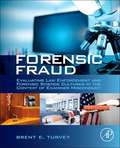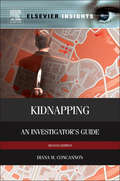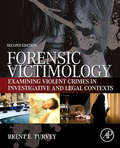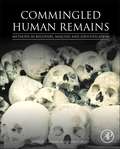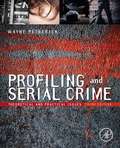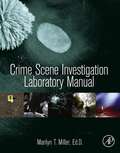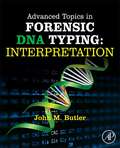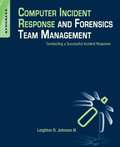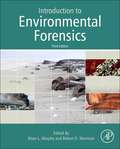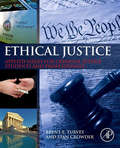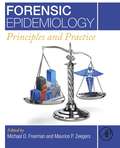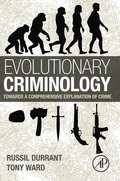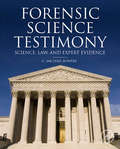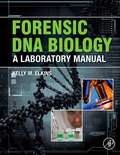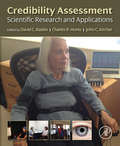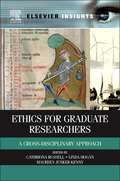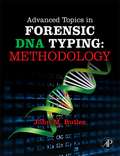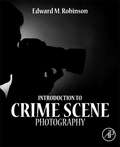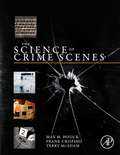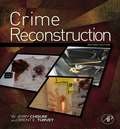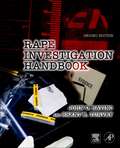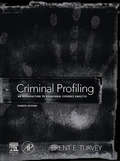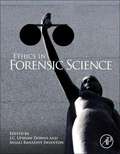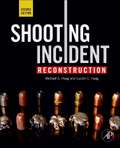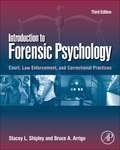- Table View
- List View
Forensic Fraud: Evaluating Law Enforcement and Forensic Science Cultures in the Context of Examiner Misconduct
by Brent E. TurveyForensic Fraud is the culmination of 12 years of research by author Brent E. Turvey. A practicing forensic scientist since 1996, Turvey has rendered this first of its kind study into the widespread problem of forensic fraud in the United States. It defines the nature and scope of the problem, the cultural attitudes and beliefs of those involved, and establishes clear systemic contributors. Backed up by scrupulous research and hard data, community reforms are proposed and discussed in light of the recently published National Academy of Sciences report on forensic science. An adaptation of Dr. Turvey’s doctoral dissertation, this volume relentlessly cites chapter and verse in support of its conclusions that law enforcement cultural and scientific values are incompatible, and that the problem of forensic fraud is systemic in nature. It begins with an overview of forensic fraud as a sub-type of occupational fraud, it explores the extent of fraud in both law enforcement and scientific employment settings, it establishes and then contrasts the core values of law enforcement and scientific cultures and then it provides a comprehensive review of the scientific literature regarding forensic fraud. The final chapters present data from Dr. Turvey’s original research into more than 100 fraudulent examiners between 2000 and 2010, consideration of significant findings, and a review of proposed reforms to the forensic science community based on what was learned. It closes with a chapter on the numerous crime lab scandals, and closures that occurred between 2010 and 2012 – an update on the deteriorating state of the forensic science community in the United States subsequent to data collection efforts in the present research. Forensic Fraud is intended for use as a professional reference manual by those working in the criminal system who encounter the phenomenon and want to understand its context and origins. It is intended to help forensic scientist and their supervisors to recognize, manage and expel it; to provide policy makers with the necessary understaffing for acknowledging and mitigating it; and to provide agents of the courts with the knowledge, and confidence, to adjudicate it. It is also useful for those at the university level seeking a strong secondary text for courses on forensic science, law and evidence, or miscarriages of justice. First of its kind overview of the cultural instigators of forensic fraudFirst of its kind research into the nature and impact of forensic fraud, with data (2000-2010)First of its kind typology of forensic fraud, for use in future case examination in researchNumerous profiles of forensic fraudstersReview of major crime lab scandals between 2010 and 2012
Kidnapping: An Investigator’s Guide
by Diana M. ConcannonKidnapping: An Investigator's Guide to Profiling is based on a three-part analysis of 100 randomly selected kidnapping cases prosecuted in the United States that have survived Supreme Court appeal. The results of the analysis are incorporated into each chapter as part of the exploration of the inductive profile of each kidnapping subtype, thereby offering a statistically based tool that can inform investigative strategies and the allocation of limited resources. The analysis includes standardized input from four levels of professional law enforcement including a forensic psychologist, a crime analyst, a detective, and a city prosecutor. In addition to chapters pertaining to the kidnapping subtypes – Domestic Kidnapping, Predatory Kidnapping-Adult Victim, Predatory Kidnapping-Child Victim, Profit Kidnapping, Revenge Kidnapping, Staged Kidnapping, and Political Kidnapping - an introductory chapter is dedicated to the evolution of U.S. kidnapping law and intervention strategies, including a review of relevant case law (Megan's Law, Amber Alert). Appendices include a concise summary of all the subtypes and Tabletop Drills that law enforcement can use to support potential kidnapping victims prepare and better respond to a kidnapping threat. The second edition also includes a discussion of the relationship between kidnapping and human trafficking, as well as a new Appendix focused upon effective interview strategies with the victim-witness. A statistically-based tool that can inform investigative strategies in kidnapping casesAn essential resource for any professional who regularly deals with the subject of kidnappingContains appendices that provide a concise summary of the statistical information presented in the textAnalysis of 100 randomly selected kidnapping cases prosecuted in the United States that have survived Supreme Court appeal
Forensic Victimology: Examining Violent Crime Victims in Investigative and Legal Contexts
by Brent E. TurveyPublished in 2009, the first edition of Forensic Victimology introduced criminologists and criminal investigators to the idea of systematically gathering and examining victim information for the purposes of addressing investigative and forensic issues. The concepts presented within immediately proved vital to social scientists researching victims-offender relationships; investigators and forensic scientists seeking to reconstruct events and establish the elements of a crime; and criminal profilers seeking to link pattern crimes. This is because the principles and guidelines in Forensic Victimology were written to serve criminal investigation and anticipate courtroom testimony. As with the first, this second edition of Forensic Victimology is an applied presentation of a traditionally theoretical subject written by criminal justice practitioners with years of experience-both in the field and in the classroom. It distinguishes the investigative and forensic aspects of applied victim study as necessary adjuncts to what has often been considered a theoretical field. It then identifies the benefits of forensic victimology to casework, providing clearly defined methods and those standards of practice necessary for effectively serving the criminal justice system. 30% new content, with new chapters on Emergency Services, False Confessions, and Human TraffickingUse of up-to-date references and case examples to demonstrate the application of forensic victimologyProvides context and scope for both the investigative and forensic aspects of case examination and evidence interpretationApproaches the study of victimology from a realistic standpoint, moving away from stereotypes and archetypesUseful for students and professionals working in relation to behavioral science, criminology, criminal justice, forensic science, and criminal investigation
Commingled Human Remains: Methods in Recovery, Analysis, and Identification
by John Byrd Bradley AdamsCommingled human remains are encountered in situations ranging from prehistoric ossuaries to recent mass fatality incidents. Commingled Human Remains: Methods in Recovery, Analysis, and Identification brings together tools from diverse sources within the forensic science community to offer a set of comprehensive approaches to resolving issues associated with commingled remains. This edition focuses on forensic situations, although some examples from prehistoric contexts are also addressed. Commingling of bones and other body parts is a major obstacle to individual identification that must be addressed before other forensic determinations or research can proceed. Regardless of the cause for the commingling (transportation disaster, terrorist attack, natural disaster, genocide, etc.) it is critical that the proper experts are involved and that the proper techniques are employed to achieve the greatest success in making identifications. Resolution of commingling nearly always requires consideration of multiple lines of evidence that cross the disciplinary lines of modern forensic science. The use of archaeology, DNA, and forensic anthropology are several areas that are critical in this process and these are core topics presented in this book. Even a relatively “simple" mass fatality event can become very complicated once body fragmentation and commingling occur. Expectations associated with all phases of the process from recovery of remains to their final identification and release to next of kin must be managed appropriately.A powerful resource for those working in the forensic sciences who need to plan for and/or address the complex challenges associated with commingled and fragmentary human remainsWritten by an international group of the foremost forensic scientists presenting their research and candid experiences of dealing with commingled human remains, offering recommendations and providing "lessons learned" which can be invaluable to others who find themselves facing similar challengesContains chapters on remains recovery, laboratory analysis, case studies, and broader topics such as mass fatality management and ethical considerations
Profiling and Serial Crime: Theoretical and Practical Issues
by Wayne PetherickProfiling and Serial Crime examines the principles of behavioral profiling and then applies them to serial crime. This book is a completely revised and updated edition of an excellent text on behavioral profiling and serial crime. It provides a theoretical and practical foundation for understanding the motivation and dynamics in a range of serial offenses. Part I of the book deals with the history, crucial issues, methods, theory, and treatment in the mainstream media. Part II discusses serial crime in detail, including bullying, stalking, rape, murder, and arson. The title of this edition reflects the focus on profiling as well as serial crime and has been updated throughout with the latest research. New to this edition are five all-new chapters, including serial harassment and cyber-bullying and the motivations of victim and offender; two replacement chapters on serial rape and serial arson; enhanced pedagogy to keep students focused on what’s important; and new ancillary materials for both instructor and student. The book consists of ancillary online materials for instructors and students, including lecture slides, test bank and case studies. Numerous case examples are included to show the real world uses of behavioral profiling in investigations. This book will appeal to professionals and students in criminal justice and forensic psychology programs, as well as those taking courses in criminal profiling, especially courses on serial crime.Provides a theoretical and practical foundation for understanding the motivation and dynamics in a range of serial offensesAncillary online materials for instructors and students, including lecture slides, test bank and case studies Numerous case examples show the real world uses of behavioral profiling in investigations
Crime Scene Investigation Laboratory Manual
by Marilyn T MillerCrime Scene Investigation Laboratory Manual provides information, examples, and exercises for all aspects of crime scene investigation. The exercises will teach the proper techniques for securing, documenting, and searching a crime scene, how to visualize or enhance the evidence found, how to package and preserve the evidence, and how to reconstruct what happened at the crime scene. This manual is intended to accompany any crime scene investigation textbook. Written by a former crime scene investigator and forensic scientist, the information is practical, straightforward, and will be immediately applicable. Learn all the latest techniques and procedures including deconstructing first responder contamination, the preliminary walk-through, utilizing associative evidence, enhancing trace, biological, and chemical evidence, and reconstructing scenes through wound dynamics, glass fracture patterns, bloodstain patterns, ballistics, and more.Designed to complement any text used in crime scene investigation coursesOver 20+ proven exercises with material from actual crime scenes, providing students with hands-on learningWritten by an experienced educator and former crime scene investigator/forensic scientist
Advanced Topics in Forensic DNA Typing: Interpretation
by John M. ButlerAdvanced Topics in Forensic DNA Typing: Interpretation builds upon the previous two editions of John Butler’s internationally acclaimed Forensic DNA Typing textbook with forensic DNA analysts as its primary audience. Intended as a third-edition companion to the Fundamentals of Forensic DNA Typing volume published in 2010 and Advanced Topics in Forensic DNA Typing: Methodology published in 2012, this book contains 16 chapters with 4 appendices providing up-to-date coverage of essential topics in this important field. Over 80 % of the content of this book is new compared to previous editions. Provides forensic DNA analysts coverage of the crucial topic of DNA mixture interpretation and statistical analysis of DNA evidence Worked mixture examples illustrate the impact of different statistical approaches for reporting results Includes allele frequencies for 24 commonly used autosomal STR loci, the revised Quality Assurance Standards which went into effect September 2011
Computer Incident Response and Forensics Team Management: Conducting a Successful Incident Response
by Leighton JohnsonComputer Incident Response and Forensics Team Management provides security professionals with a complete handbook of computer incident response from the perspective of forensics team management. This unique approach teaches readers the concepts and principles they need to conduct a successful incident response investigation, ensuring that proven policies and procedures are established and followed by all team members. Leighton R. Johnson III describes the processes within an incident response event and shows the crucial importance of skillful forensics team management, including when and where the transition to forensics investigation should occur during an incident response event. The book also provides discussions of key incident response components.Provides readers with a complete handbook on computer incident response from the perspective of forensics team managementIdentify the key steps to completing a successful computer incident response investigationDefines the qualities necessary to become a successful forensics investigation team member, as well as the interpersonal relationship skills necessary for successful incident response and forensics investigation teams
Introduction to Environmental Forensics
by Brian L. Murphy Robert D. MorrisonThe third edition of Introduction to Environmental Forensics is a state-of-the-art reference for the practicing environmental forensics consultant, regulator, student, academic, and scientist, with topics including compound-specific isotope analysis (CSIA), advanced multivariate statistical techniques, surrogate approaches for contaminant source identification and age dating, dendroecology, hydrofracking, releases from underground storage tanks and piping, and contaminant-transport modeling for forensic applications. Recognized international forensic scientists were selected to author chapters in their specific areas of expertise and case studies are included to illustrate the application of these methods in actual environmental forensic investigations. This edition provides updates on advances in various techniques and introduces several new topics.Provides a comprehensive review of all aspects of environmental forensicsCoverage ranges from emerging statistical methods to state-of-the-art analytical techniques, such as gas chromatography-combustion-isotope ratio mass spectrometry and polytopic vector analysisNumerous examples and case studies are provided to illustrate the application of these forensic techniques in environmental investigations
Ethical Justice: Applied Issues for Criminal Justice Students and Professionals
by Brent E. Turvey Stan CrowderThis textbook was developed from an idiom shared by the authors and contributors alike: ethics and ethical challenges are generally black and white - not gray. They are akin to the pregnant woman or the gunshot victim; one cannot be a little pregnant or a little shot. Consequently, professional conduct is either ethical or it is not. Unafraid to be the harbingers, Turvey and Crowder set forth the parameters of key ethical issues across the five pillars of the criminal justice system: law enforcement, corrections, courts, forensic science, and academia. It demonstrates how each pillar is dependent upon its professional membership, and also upon the supporting efforts of the other pillars - with respect to both character and culture.With contributions from case-working experts across the CJ spectrum, this text reveals hard-earned insights into issues that are often absent from textbooks born out of just theory and research. Part 1 examines ethic issues in academia, with chapters on ethics for CJ students, CJ educators, and ethics in CJ research. Part 2 examines ethical issues in law enforcement, with separate chapters on law enforcement administration and criminal investigations. Part 3 examines ethical issues in the forensic services, considering the separate roles of crime lab administration and evidence examination. Part 4 examines ethical issues in the courts, with chapters discussing the prosecution, the defense, and the judiciary. Part 5 examines ethical issues in corrections, separately considering corrections staff and treatment staff in a forensic setting. The text concludes with Part 6, which examines ethical issues in a broad professional sense with respect to professional organizations and whistleblowers.Ethical Justice: Applied Issues for Criminal Justice Students and Professionals is intended for use as a textbook at the college and university, by undergraduate students enrolled in a program related to any of the CJ professions. It is intended to guide them through the real-world issues that they will encounter in both the classroom and in the professional community. However, it can also serve as an important reference manual for the CJ professional that may work in a community that lacks ethical mentoring or leadership.First of its kind overview of the five pillars of criminal justice: academia, law enforcement, forensic services, courts and correctionsWritten by practicing criminal justice professionals, from across every pillarOffers a realistic overview of ethical issues confronted by criminals justice students and professionalsExamines sensitive subjects often ignored in other criminal justice ethics textsNumerous cases examples in each chapter to facilitate instruction and learning
Forensic Epidemiology: Principles and Practice
by Michael Freeman Maurice ZeegersIt is an inescapable fact that causation, both generally (in populations), and specifically (in individuals), cannot be observed. Rather, causation is determined when it can be inferred that the risk of an observed injury or disease from a plausible cause is greater than the risk from other plausible causes. While many causal evaluations performed in forensic medicine are simplified by the fact that the circumstances surrounding the onset of an injury or disease clearly rules out competing causes (eg, a death following a fall), there are many cases that present a more complicated picture. It is these types of investigations, in which an analysis of comparative levels of risk from competing causes is needed to arrive at a reliable and accurate determination of the most likely cause, that forensic epidemiology (FE) is directed at.In Forensic Epidemiology, the authors present the legal and scientific theories underlying the methods by which risk is used in the investigation of individual causation. Methods and principles from epidemiology are combined with those from a multitude of other disciplines, including general medicine, pharmacology, forensic pathology, biostatistics, and biomechanics, inter alia, as a basis for investigating the plausibility of injury and disease exposures and mechanisms. The ultimate determination of the probability of causation (PC) results from an assessment of the strength of association of the investigated relationship in the individual, based on a comparison between the risk of disease or injury from the investigated exposure versus the risk of the same disease or injury occurring at the same point in time in the individual, but absent the exposure. The principles and methods described in Forensic Epidemiology will be of interest to those who work and study in the fields of forensic medicine, epidemiology, and the law. Historical perspective on how epidemiologic evidence of causation has been used in courts in the US and Europe Theory and science underlying the use of risk to assess individual causation Primer on epidemiologic methods, and various measures used to arrive at individualized comparative risk assessments and PC The use of statistical methods applied to publicly available data for ad hoc analysis of PC applicable to the specific circumstances of a case Background on complementary disciplines, including forensic pathology, death investigation, biomechanics, and survival analysis Examples of applied FE in the investigation of traffic injury and death, automotive and other product defect litigation, medical negligence, and criminal prosecution and defense
Evolutionary Criminology: Towards a Comprehensive Explanation of Crime
by Tony Ward Russil DurrantIn our attempts to understand crime, researchers typically focus on proximate factors such as the psychology of offenders, their developmental history, and the social structure in which they are embedded. While these factors are important, they don't tell the whole story. Evolutionary Criminology: Towards a Comprehensive Explanation of Crime explores how evolutionary biology adds to our understanding of why crime is committed, by whom, and our response to norm violations. This understanding is important both for a better understanding of what precipitates crime and to guide approaches for effectively managing criminal behavior. This book is divided into three parts. Part I reviews evolutionary biology concepts important for understanding human behavior, including crime. Part II focuses on theoretical approaches to explaining crime, including the evolution of cooperation, and the evolutionary history and function of violent crime, drug use, property offending, and white collar crime. The developmental origins of criminal behavior are described to account for the increase in offending during adolescence and early adulthood as well as to explain why some offenders are more likely to desist than others. Proximal causes of crime are examined, as well as cultural and structural processes influencing crime. Part III considers human motivation to punish norm violators and what this means for the development of a criminal justice system. This section also considers how an evolutionary approach contributes to our understanding of crime prevention and reduction. The section closes with an evolutionary approach to understanding offender rehabilitation and reintegration.Reviews how evolutionary findings improve our understanding of crime and punishmentExamines motivations to offend, and to punish norm violatorsArticulates evolutionary explanations for adolescent crime increaseIdentifies how this knowledge can aid in crime prevention and reduction, and in offender rehabilitation
Forensic Testimony: Science, Law and Expert Evidence
by C. Michael BowersForensic Testimony: Science, Law and Expert Evidence—favored with an Honorable Mention in Law & Legal Studies at the Association of American Publishers' 2015 PROSE Awards—provides a clear and intuitive discussion of the legal presentation of expert testimony. The book delves into the effects, processes, and battles that occur in the presentation of opinion and scientific evidence by court-accepted forensic experts. It provides a timely review of the United States Federal Rules of Evidence (FRE) regarding expert testimony, and includes a multi-disciplinary look at the strengths and weaknesses in forensic science courtroom testimony. The statutes and the effects of judicial uses (or non-use) of the FRE, Daubert, Kumho, and the 2009 NAS Report on Forensic Science are also included. The presentation expands to study case law, legal opinions, and studies on the reliability and pitfalls of forensic expertise in the US court system. This book is an essential reference for anyone preparing to give expert testimony of forensic evidence.Honorable Mention in the 2015 PROSE Awards in Law & Legal Studies from the Association of American PublishersA multi-disciplinary forensic reference examining the strengths and weaknesses of forensic science in courtroom testimonyFocuses on forensic testimony and judicial decisions in light of the Federal Rules of Evidence, case interpretations, and the NAS report findingsCase studies, some from the Innocence Project, assist the reader in distinguishing good testimony from bad
Forensic DNA Biology: A Laboratory Manual
by Kelly M. ElkinsDNA typing has revolutionized criminal investigations and has become a powerful tool in the identification of individuals in criminal and paternity cases. Forensic DNA Biology: A Laboratory Manual is comprised of up-to-date and practical experiments and step-by-step instructions on how to perform DNA analysis, including pipetting, microscopy and hair analysis, presumptive testing of body fluids and human DNA typing. Modern DNA typing techniques are provided, reflecting real life, where not all institutions and crime labs can afford the same equipment and software. Real case studies will be used throughout. Provides practical step-by-step instruction on how to perform forensic DNA analysisIncludes analysis of hair, presumptive testing of body fluids, human DNA typing and statisticsCovers techniques such as pipetting, microscopy and DNA extractionPre- and post-lab exercises and questions assist the reader in learning the materialReport writing templates assure the reader learns real world crime lab procedure
Credibility Assessment: Scientific Research and Applications
by David C. Raskin Charles R. Honts John C. KircherIn 2001, the late Murray Kleiner and an array of experts contributed to the Handbook of Polygraph Testing, published by Elsevier, which examined the fundamental principles behind polygraph tests and reviewed the key tests and methods used at that time. In the intervening thirteen years, the field has moved beyond traditional polygraph testing to include a host of biometrics and behavioral observations. The new title reflects the breadth of methods now used. Credibility Assessment builds on the content provided in the Kleiner volume, with revised polygraph testing chapters and chapters on newer methodologies, such as CNS, Ocular-motor, and behavioral measures. Deception detection is a major field of interest in criminal investigation and prosecution, national security screening, and screening at ports of entry. Many of these methods have a long history, e.g., polygraph examinations, and some rely on relatively new technologies, e.g., fMRI and Ocular-motor measurements. Others rely on behavioral observations of persons in less restricted settings, e.g., airport screening. The authors, all of whom are internationally-recognized experts associated with major universities in the United States, United Kingdom, and Europe, review and analyze various methods for the detection of deception, their current applications, and major issues and controversies surrounding their uses. This volume will be of great interest among forensic psychologists, psychophysiologists, polygraph examiners, law enforcement, courts, attorneys, and government agencies. Provides a comprehensive review of all aspects of methods for deception detectionIncludes methods being used in credibility, such as autonomic, CNS, fMRI, and Ocular-motor measures and behavioral and facial observationEdited by leaders in the field with over 25+ years of experienceDiscusses theory and application
Ethics for Graduate Researchers: A Cross-disciplinary Approach
by Linda Hogan Maureen Junker-Kenny Cathriona RussellThis edited collection is intended as a primer for core concepts and principles in research ethics and as an in-depth exploration of the contextualization of these principles in practice across key disciplines. The material is nested so that readers can engage with it at different levels and depths. It is unique in that it combines an analysis of complex ethical debates about the nature of research and its governance with the best of case-based and discipline-specific approaches. It deals with the following topics in depth: in the natural sciences, it explores the scientific integrity of the researcher and the research process, human cloning as a test case for the limits to research, and the emerging ethical issues in nanotechnology; in the health sciences, it takes up the question of consent, assent and proxies, research with vulnerable groups and the ethics of clinical trials; in the social sciences, it explores the issues that arise in qualitative research, interviews and ethnography; and in the humanities, it examines contested archaeologies and research in divided societies.Overview of Research Ethics PrinciplesFull text papers from experienced researchers across many disciplinesDialogue with ethicists
Advanced Topics in Forensic DNA Typing: Methodology
by John M. ButlerIntended as a companion to the Fundamentals of Forensic DNA Typing volume published in 2009, Advanced Topics in Forensic DNA Typing: Methodology contains 18 chapters with 4 appendices providing up-to-date coverage of essential topics in this important field and citation to more than 2800 articles and internet resources. The book builds upon the previous two editions of John Butler’s internationally acclaimed Forensic DNA Typing textbook with forensic DNA analysts as its primary audience. This book provides the most detailed information written to-date on DNA databases, low-level DNA, validation, and numerous other topics including a new chapter on legal aspects of DNA testing to prepare scientists for expert witness testimony. Over half of the content is new compared to previous editions. A forthcoming companion volume will cover interpretation issues.Contains the latest information - hot-topics and new technologiesWell edited, attractively laid out, and makes productive use of its four-color formatAuthor John Butler is ranked as the number one "high-impact author in legal medicine and forensic science, 2001 to 2011" by ScienceWatch.com
Introduction to Crime Scene Photography
by Edward M. RobinsonIntroduction to Crime Scene Photography acquaints the reader with the essentials of basic crime scene photography techniques. It looks at the concepts related to composition and relates them to the types of photographs captured by crime scene photographers. It explains how to capture images based on the exposure settings chosen to produce the effect desired. It considers the techniques used needed to control and maximize Depth of Field (DOF), and reviews how the different lenses will affect an image. Organized into seven chapters, the book begins with an overview of crime scene photography and composition, including the three cardinal rules of good photography. It then proceeds with a discussion of the benefits of bounce flash and how to utilize this technique to properly compose the subject of interest. It also explains how to capture any image necessary at the crime scene by combining the concepts of composition, nonflash exposure, DOF, flash exposure, and the use of various types of lenses. In addition, the reader is introduced to various energy sources and filters, digital processing of evidentiary photography, and legal issues related to photographs and digital images. Examples and illustrations are provided throughout to demonstrate how the concepts examined tend to form a sort of symbiotic relationship. This text will benefit scene investigators and photographers, forensic consultants, forensic scientists, undergraduate students in forensic and/or criminal justice programs, law enforcement professionals, and anyone who wants to acquire the skills needed to be a successful crime scene photographer. Contains over 350 high-quality 4-color imagesRules of Thumb are included to highlight key concepts
The Science of Crime Scenes
by Max M. Houck Frank Crispino Terry McAdamThe Science of Crime Scenes addresses the science of crime scene investigation and processing, including the latest methods and technologies. This book covers the philosophy of crime scenes as historical events, the personnel involved at a scene (including the media), the detection of criminal traces and their reconstruction, and special crime scenes, such as mass disasters and terrorist events. Written by an international trio of authors with decades of crime scene experience, it is the next generation of crime scene textbooks. The book provides in-depth coverage of disasters and mass murder, terror crime scenes, and CBRN (chemical, biological, radioactive and nuclear) – topics not covered in any other text. It includes an instructor website with lecture slides, test bank, outlines, definitions, and activities, along with a student companion site with an image collection. This text will be of interest to advanced undergraduate and graduate students in forensic science programs, as well as to forensic practitioners and crime scene technicians. Offers a science-based approach to crime scene investigationIncludes in-depth coverage of disasters and mass murder, terror crime scenes, and CBRN (chemical, biological, radioactive and nuclear) – not covered in any other textWritten by an international trio of authors with decades of crime scene experienceInstructor website with lecture slides, test bank, outlines, definitions, and activities, and a student companion site with an image collection
Crime Reconstruction
by Brent E. Turvey W. Jerry ChisumCrime Reconstruction, Second Edition is an updated guide to the interpretation of physical evidence, written for the advanced student of forensic science, the practicing forensic generalist and those with multiple forensic specialists. It is designed to assist reconstructionists with understanding their role in the justice system; the development and refinement of case theory’ and the limits of physical evidence interpretation. Chisum and Turvey begin with chapters on the history and ethics of crime reconstruction and then shift to the more applied subjects of reconstruction methodology and practice standards. The volume concludes with chapters on courtroom conduct and evidence admissibility to prepare forensic reconstructionists for what awaits them when they take the witness stand. Crime Reconstruction, Second Edition, remains an unparalleled watershed collaborative effort by internationally known, qualified, and respected forensic science practitioner holding generations of case experience among them. Forensic pioneer such as W. Jerry Chisum, John D. DeHaan, John I. Thorton, and Brent E. Turvey contribute chapters on crime scene investigation, arson reconstruction, trace evidence interpretation, advanced bloodstain interpretation, and ethics. Other chapters cover the subjects of shooting incident reconstruction, interpreting digital evidence, staged crime scenes, and examiner bias. Rarely have so many forensic giants collaborated, and never before have the natural limits of physical evidence been made so clear. Updates to the majority of chapters, to comply with the NAS Report New chapters on forensic science, crime scene investigation, wound pattern analysis, sexual assault reconstruction, and report writing Updated with key terms, chapter summaries, discussion questions, and a comprehensive glossary; ideal for those teaching forensic science and crime reconstruction subjects at the college level Provides clear practice standards and ethical guidelines for the practicing forensic scientist
Rape Investigation Handbook
by Brent E. Turvey John O. SavinoRape Investigation Handbook details specific investigative and forensic processes related to sex crimes casework invaluable to those in law enforcement, the legal community, and the private sector. It takes the reader through these processes in a logical sequence, showing how investigations of rape and sexual assault can and should be conducted from start to finish. The second edition is reorganized to flow from the alleged assault to a courtroom trial. Section heads have been introduced and it includes six new chapters on sex crimes, sex trafficking, forensic victimology, eyewitness reports, rape trauma syndrome and rapist motivations. The remaining 12 chapters are entirely overhauled and in some cases completely rewritten by new, highly qualified contributors, such as "Sexual Assault Examination and Reconstruction" by Brent E. Turvey and Charla Jamerson and "Rapist Motivations" by Brent E. Turvey and Jodi Freeman. An additional appendix was added to provide current case studies. Includes six new chapters on sex crimes, sex trafficking, forensic victimology, eyewitness reports, rape trauma syndrome and rapist motivations Written in a clear, practical style, ideal for sex crime investigators including: professionals in forensic nursing, forensic laboratories, law enforcement and the legal community Authored by qualified investigators and forensic professionals with over 30 years of collective experience working cases, preparing them for court and offering testimony
Criminal Profiling: An Introduction to Behavioral Evidence Analysis
by Brent E. TurveyFocused on Behavioral Evidence Analysis (BEA), a method of criminal profiling developed and refined by the author over the past 15 years, the fourth edition of Criminal Profiling maintains the same core foundation that made previous editions best sellers in the professional and academic community worldwide. Written from practicing behavioral analysts and aspiring students alike, this work emphasizes an honest understanding of crime and criminals. Newly updated, mechanisms for the examination and classification of both victim and offender behavior have been improved. In addition to refined approaches towards victimology, crime scene analysis, motivation and case linkage, a chapter on sexual deviance has been added as well. With prior edition in wide use as a primary text in criminal justice, law, criminology, and behavioral science programs around the world, Criminal Profiling, Fourth Edition remains essential for students and professionals alike. Outlines the scientific principles and practice standards of BEA-oriented criminal profiling, with an emphasis on applying theory to real casesContributing authors from law enforcement, academic, mental health and forensic science communities provide a balance perspectiveComplete glossary of key terms Companion Web site includes all appendices from previous volumes and figure collection at http://www.elsevierdirect.com/companions/9780123852434Manual Web site provides an instructor’s manual for each chapter, powerpoint slideshows, and case reports from Brent Turvey’s work
Ethics in Forensic Science
by J.C. Upshaw Downs Anjali Ranadive SwientonThis work will draw upon the expertise of the editors as authors and various contributors in order to present several different perspectives with the goal of approaching and understanding when ethical lines are crossed. In order to achieve this goal, comparisons of various canons of ethics from related fields such as medicine, law, the military, science and politics will be examined and applied. Case studies will be presented throughout to illustrate ethical dilemmas and challenge the reader with the goal of greater understanding. First book to comprehensively address ethics in forensics beyond the laboratoryReal-life cases presented involving unethical behavior to illustrate conceptsDiscusses ethical considerations while delineating opinion from fact in testimonyPlaces forensic ethics within the canons of the legal and medical systems
Shooting Incident Reconstruction
by Michael G. Haag Lucien C. HaagShooting Incident Reconstruction, Second Edition, offers a thorough explanation of matters from simple to complex to help the reader understand the factors surrounding ballistics, trajectory, and shooting scenes. Forensic scientists, law enforcement, and crime scene investigators are often tasked with reconstruction of events based on crime scene evidence, along with the subsequent analysis of that evidence. The use and misuse of firearms to perpetrate crimes from theft to murder necessitates numerous invitations to reconstruct shooting incidents. The discharge of firearms and the behavior of projectiles create many forms of physical evidence that, through proper testing and interpretation by a skilled forensic scientist, can establish what did and what did not occur. Written by the world's most well-respected shooting scene and ballistics experts, the book addresses the terminology, science, and factors involved in reconstructing shooting incident events to solve forensic cases. It covers the full range of related topics including: the range from which a firearm was discharged; the sequence of shots in a multiple discharge shooting incident; the position of a firearm at the moment of discharge; and the position of a victim at the moment of impact. The probable flight path of a projectile and the manner in which a firearm was discharged are also discussed. Case studies illustrate real-world application of technical concepts, supported by over 200 full-color diagrams and photographs. This book will be of value to practicing forensic scientists (firearm and toolmark examiners), ballistics experts, crime scene personnel, police departments, forensic consultants (generalists), attorneys and judges, medical examiners (coroners), and forensic pathologists.Written by the most well-respected shooting scene and ballistics experts in the worldContains over 200 full-color diagrams and photographs that support and illustrate key conceptsCase studies illustrate real-world application of technical concepts
Introduction to Forensic Psychology: Court, Law Enforcement, and Correctional Practices
by Bruce A. Arrigo Stacey L. ShipleyIntroduction to Forensic Psychology, Third Edition, has been completely restructured to explain in greater detail how courses on forensic psychology are taught, making it more applicable as a textbook than previous editions. It also features more figures, tables and text boxes, making it a true textbook. What this book has that others do not is equal representation of criminal behavior, the court systems, and law enforcement/prisons. It also has equal representation of criminal and civil forensics. Other texts tend to be weighted towards just criminal behavior or just criminal justice and primarily criminal or civic forensics but not both. This new edition also has equal representation of issues to pertaining to adults and children. It contains new coverage of cyberbullying, tests and assessments in the courtroom, mental deficiency and competency to stand trial, and information on mothers who kill their children. Adult, juvenile and family issues are dealt with separately, making it easier to find what you need. Case illustrations dramatically highlight how the lives of individuals have been (or could be) impacted by developments in psychology and law. Chapters now include pedagogy, including outlines, main points, and relevant websites. This book is intended for professors teaching introduction to forensic psychology, as well as for students interested in adult, child, and family forensics as they apply to criminal and civic forensics law enforcement/prisons. Newly structured to map closer to how this information is taught and learnedComprehensive coverage ensures inclusion of criminal and civic forensics as well as police and law enforcementChapters now include pedagogy, including outlines, main points, and relevant websites
